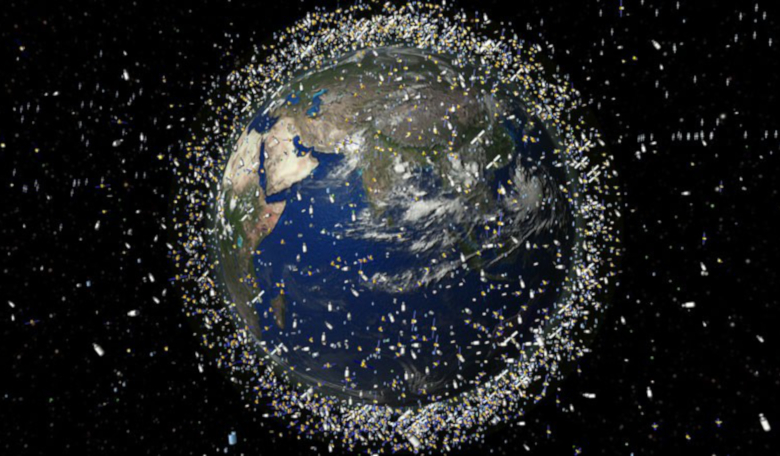Following the likes of SpaceX and Amazon who aim to loft thousands of satellites into space to enable off-world internet services, a Chinese company named GW has filed for spectrum allocation from the International Telecommunication Union for two broadband constellations that would include 12,992 satellites.
The constellations, called GW-A59 and GW-2, would be on a par with the 12,000 satellites SpaceX originally sought approval for from the US Federal Communications Commission (FCC) and “implies an intention to compete in the end-user broadband service market,” writes Larry Press, a Professor of Information Systems at California State University.
If this is GW’s intention, Press surmises that the company will focus its attention on providing an orbital broadband service to locations where China already has established "Digital Silk Road" (DSR) projects.
The DSR – an orbital equivalent to the land based Silk Road Economic Belt – is part of China's ambitions Belt and Road initiative (BRI), also known as One Belt One Road.
It has infrastructure projects in around 70 nations currently concentrated in Eastern Europe, Asia, the Middle East and Africa and satellites are expected to become a central part of the initiative.
China are already planning three low-Earth orbit (LEO) satellite constellations; Hongyun, which plans 864 satellites; Hongyan, which plans around 320 satellites, and Galaxy Space.
While these three are oriented toward broadband communication, none of them seem to be pursuing the global consumer market that SpaceX and other companies such as OneWeb hope to serve, says Press, except for GW.
With over half the people in the world living in or near China and India, GW would be well placed to providing broadband to these regions, as SpaceX infer they will be focusing initially on North America, then perhaps Europe.
Nonetheless, whatever GW’s motive, the application means that a further 12,000 satellites will potentially fill the skies in the near future; a trend that is getting big astronomical observatories worried.
To coincide with #WorldSpaceWeek, the Square Kilometre Array Organisation (SKAO), which leads the delivery of the international Square Kilometre Array (SKA) project – has today published a preliminary analysis of the potential impact of current satellite mega-constellations on its telescopes, and it doesn't look good.
“Satellite mega-constellations don’t just affect optical and IR astronomy,” warns SKA Director General Phil Diamond via Twitter. “Without corrective actions they will have a major impact on radio astronomy.”
When completed, the Square Kilometre Array (SKA) will have an effective collecting area of one square kilometre (one million square metres) spread over Australia and South Africa, making it the world’s largest radio telescope.
Although the two SKAO telescopes will be built in remote locations far away from artificial Earth-based radio frequency interference, such as mobile phones, WiFi, etc, some of the frequency ranges the SKA will observe overlaps with radio transmissions from satellite constellations.
These frequencies covers the range from 8.3 – 15.4 GHz and are referred to as band 5b. Satellite downlink frequencies utilise 10.7 – 12.7 GHz - a range that is also immediately adjacent to an internationally protected radio astronomy band (10.6 – 10.7 GHz).
Radio observations in these frequency ranges have been conducted before, but so far, there has been little problem because of the relatively low number of satellites in orbit.
Stick thousands more satellites in low earth orbit (LEO) however and this situation will inevitably change.
One of the consequences of deploying *just* 6,400 satellites, will result in astronomical observations in that range taking 70 percent longer report the SKA.
“A loss of observing efficiency on top of the expected large oversubscription on the telescope will translate directly into lost science and it is quite possible that the most challenging experiments that might otherwise have been undertaken will no longer be viable at all in these circumstances,” says Dr Robert Braun, SKA Science Director.
The study of molecular and atomic spectral lines in that range, including complex organic molecules will also be greatly affected find the SKAO. “This is only one of many exciting science goals that depend on sensitive access to this frequency range. The prospect of losing sensitivity in this key frequency band is extremely worrying.”
The situation becomes even more dire if significantly larger constellations of up to 100,000 satellites make their way into space, says the SKA report.
“The effect on the SKA would be much worse, potentially threatening the viability of the complete Band 5b for 100% of the time, unless stringent mitigation actions are put in place.”
These mitigation techniques need to implemented by relevant satellite operators, says the report, which criticised a recent announcement made by Elon Musk.
“Starlink won’t be seen by anyone unless looking very carefully and will have ~0 percent impact on advancements in astronomy,” said the SpaceX founder. A sentiment not shared by the SKAO study, which noted that for radio telescopes in general and for SKA in particular, “this is not the case.”
However, the SKAO say they want to continue working with industry to find a way forward.
“We are building a multi-billion euro state-of-the-art research facility funded by taxpayers around the world, and we need to protect and maximise its ability to deliver innovation and new knowledge for humanity,” Diamond added. “We look forward to satellite operators’ proactive engagement with the solutions we propose here today.”











